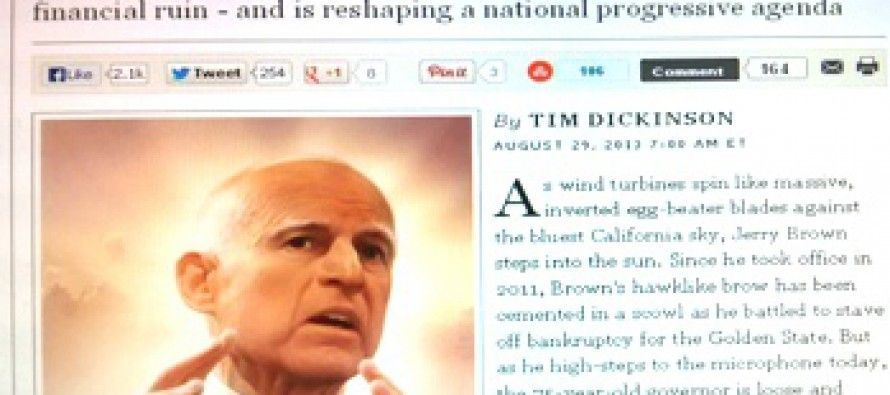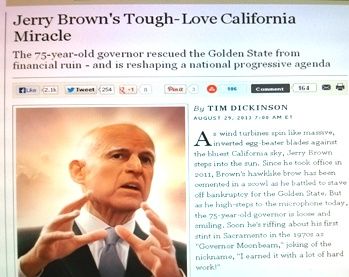Top 7 CA facts that Jerry Brown-loving national media always ignore

 The national media’s love-in with Gov. Jerry Brown continues, with the latest fawnfest coming from Rolling Stone reporter Tim Dickinson.
The national media’s love-in with Gov. Jerry Brown continues, with the latest fawnfest coming from Rolling Stone reporter Tim Dickinson.
“Just two years ago, the idea that California could be a global model for anything was laughable. When Brown took office, the state was staggered by double-digit unemployment, a $26 billion deficit and an accumulated ‘wall of debt’ topping $35 billion. California was a punch line for Republican politicos – a cautionary tale, they said, of the fate that awaits the nation should it embrace Left Coast-style economic, social and environmental liberalism. On the campaign trail in 2012, Mitt Romney joked that ‘America is going to become like Greece, or like Spain, or Italy, or like . . . California.’
“But in astonishingly short order, America’s shrewdest elder statesmen blazed a best-worst way out of California’s economic morass. With a stiff cocktail of budget cuts and hard-won new taxes, Brown has not only zeroed out the deficit, he’s also begun paying down the debt. ‘Jerry Brown’s leadership is a rebuttal to the failed policies of Republicans in Washington,’ says Neera Tanden, president of the Center for American Progress. ‘California is proving you can have sane tax systems, raise revenues, eliminate structural deficits and have economic growth.’
“Fed up with the state’s own obstructionist Republicans, California voters have even given Brown a Democratic supermajority in the state legislature. As a result, the Golden State is now reasserting itself as a proving ground for the kind of bold ideas that Republicans have roadblocked in Washington – including a cap-and-trade carbon market, high-speed rail and education-funding reform.”
Sigh. Did Jerry Brown write this himself?
Drum roll, please
The real Cali story is infinitely darker. It’s time for The Top 7 Things The National Media Always Ignore About Jerry Brown.
 1. California has the worst poverty rate of any state. Worse than Mississippi. Worse than West Virginia. Worse than Nevada. So much for the narrative of Jerry Brown as Mr. Economic Growth.
1. California has the worst poverty rate of any state. Worse than Mississippi. Worse than West Virginia. Worse than Nevada. So much for the narrative of Jerry Brown as Mr. Economic Growth.
2. California’s unemployment rate may be down from its past high, but that’s not because of any broad economic rebound at all, it’s because part-time jobs are growing and hundreds of thousands of residents have stopped looking for jobs. In the Labor Department’s U-6 category, measuring the percentage of adults who want full-time jobs but can’t find them, California has the second worst rate in the U.S. About 19 percent of these workers — nearly one in five — can’t find work.
3. The idea that the state’s finances are in good shape depends on really aggressive cherry-picking. Here’s what I wrote in June:
“California is far from being in good fiscal health. When Gov. Jerry Brown talks about reducing the ‘wall of debt’ he inherited upon taking office three years ago, he leaves out huge problems — problems that Sacramento has either not addressed or barely addressed:
“• $87 billion in unfunded liabilities for the California Public Employees’ Retirement System. The $87 billion would be far higher if not for the rosy investment assumptions used by CalPERS.
“• $73 billion in unfunded liabilities for the California State Teachers’ Retirement System, a sum that increases a staggering $6 billion a year. The $73 billion would be far higher if not for the rosy investment assumptions by CalSTRS.
“• $64 billion in unfunded liabilities for health insurance coverage guaranteed to retired employees.
“• $8.2 billion in money borrowed from the federal government to replenish the state’s broke unemployment compensation fund. California only pays the interest on the debt.”
A ‘recovery’ that the Occupyers should loathe
 4. Brown ran for office in 2010 on the promise of creating hundreds of thousands of “green” jobs that would shore up the state’s beleaguered middle class. Just as experts predicted, this never came to pass. “Green” jobs are a niche in the larger economy, not a staple. Which brings us to this never-mentioned point…
4. Brown ran for office in 2010 on the promise of creating hundreds of thousands of “green” jobs that would shore up the state’s beleaguered middle class. Just as experts predicted, this never came to pass. “Green” jobs are a niche in the larger economy, not a staple. Which brings us to this never-mentioned point…
5. The economic recovery that California is seeing is of the sort that would infuriate the Occupy types if they paid attention. The rebound is very much concentrated in elite tech jobs in Silicon Valley and parts of Southern California where innovative companies specializing in information technology, biotechnology and other life sciences are doing well. As the Rolling Stone article notes, state revenue is rebounding because of capital gains being paid. It’s not because of income tax revenue broadly raising. That would be a sign of a middle-class recovery. That’s not happening.
6. The education “reform” that Rolling Stone trumpets — giving more money to local schools with the most English-learners — is paired with the governor’s push to increase local control of school districts. What’s wrong with this? Oh, just about everything, as I’ve noted here before.
“Local control of public schools — and the stagnation, complacency and deference to the interests of adult employees it typically yields — is what drove the two big moments in U.S. education reform history. …
“The first pivotal moment came in 1983 when the National Commission on Excellence in Educational Excellence released ‘A Nation at Risk’ … . The report powerfully and at great length detailed the inertia and resistance to new approaches, technologies, standards and measurement of student and teacher performance in local school districts. …
“By the late 1990s, education reform was again a hot topic, and in both parties. After George W. Bush’s election in 2000, the president worked with Sen. Ted Kennedy on a new federal push for education reform, which ended up being the No Child Left Behind legislation. …
“The single biggest factor [driving reform] was the sense that public schools were stuck in a time warp, with far too many school districts delivering unchallenging, substandard educations suitable for a low-skill workforce in a low-tech economy. …
“Against this backdrop, it is mind-boggling that Jerry Brown thinks local control is the recipe for empowering schools. Instead, it is the recipe for (further) empowering teachers unions, which are almost always the most powerful force at the local level.”
Bullet train is ‘visionary’? Try ‘hallucinatory’
 7. The high-speed rail project that the Rolling Stone article salutes is illegal in its present form under state law because it has failed to meet environmental and funding requirements. It was sold to the public with lies.
7. The high-speed rail project that the Rolling Stone article salutes is illegal in its present form under state law because it has failed to meet environmental and funding requirements. It was sold to the public with lies.
And, oh yeah, it’s NOT EVEN HIGH-SPEED RAIL! Under its present iteration, it would take five-hours-plus to go from Los Angeles to San Francisco because you’re using regular trains from San Jose to San Francisco and from northern L.A. County to downtown L.A., that’s not a true bullet-train experience. And, oh yeah, that’s also a violation of state law, which says the run from L.A. to S.F. has to be two hours and 40 minutes maximum.
Oh, yeah, that’s a reason to stand up and cheer for Jerry Brown.
All this said, California libertarians and small-government fans shouldn’t downplay Brown’s positives. He’s much more of a fiscal conservative than any Democrat with power that I’ve ever seen in Sacramento. He also likes to veto bills because of what seems like a minimalist aesthetic — rare in any politician — that sees laws as clutter.
But any time we see the narrative that Jerry Brown has revived a broken state, libertarians and small-government fans should object as vociferously as possible.
At least after having a good laugh at the latest East Coast yokel to head west and find himself dazzled and seduced by Edmund G. Brown Jr., our silver-tongued septuagenarian of a state executive.
Tim Dickinson, join the crowd.
Related Articles
Taxpayer-subsidized companies raking in public contracts
Los Angeles County is hitting 1.000. The county has done business with each of the top 10 recipients of local
Lawmakers Push Harebrained Bills
Katy Grimes: A ridiculous bill which would have California condo and home owners replacing lawns and traditional grass with astro turf, was
Helmut Hair No More
Katy Grimes: Five different attempts at repealing California’s motorcycle helmet law have been defeated by the Legislature, but that isn’t



